Comprehensive Financial Report: Tesco's Ratios and PESTLE Analysis
VerifiedAdded on 2023/06/15
|17
|4897
|452
Report
AI Summary
This report presents a comprehensive financial analysis of Tesco Plc, a multinational corporation operating in the supermarket and hypermarket sector. It includes a company profile, calculation and interpretation of key financial ratios (profitability, liquidity, gearing, efficiency, and investment ratios) based on Tesco's financial reports, and a PESTLE analysis to evaluate the external factors influencing the company. The ratio analysis assesses Tesco's profitability trends, liquidity management, financial risk, operational efficiency, and investment attractiveness. The PESTLE analysis examines the political, economic, social, technological, legal, and environmental factors affecting Tesco's business environment. The report concludes with a recommendation on whether an investor should invest in Tesco, based on the combined insights from the financial ratios, SWOT, and PESTLE analyses. Desklib provides students access to similar solved assignments and study tools.
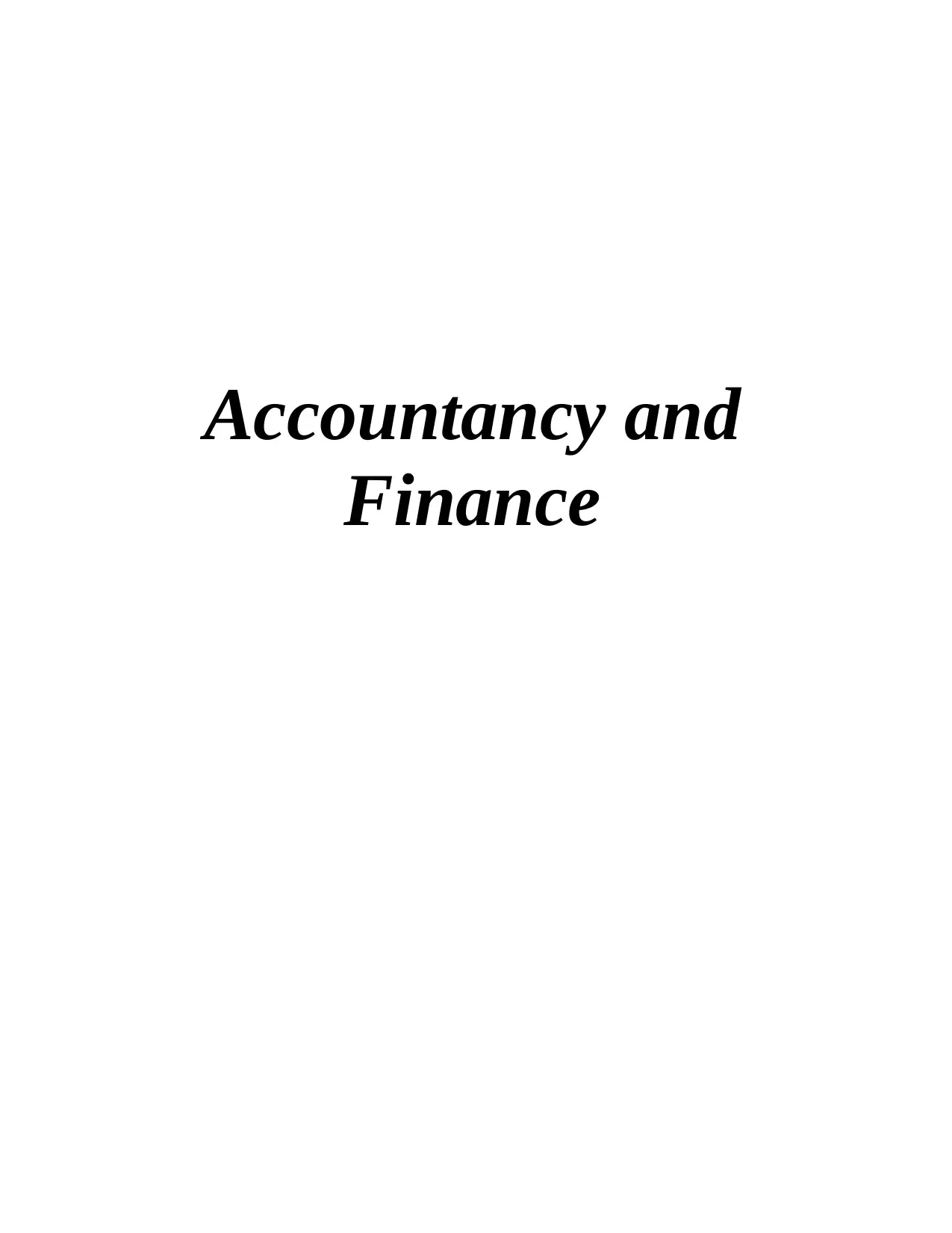
Accountancy and
Finance
Finance
Paraphrase This Document
Need a fresh take? Get an instant paraphrase of this document with our AI Paraphraser
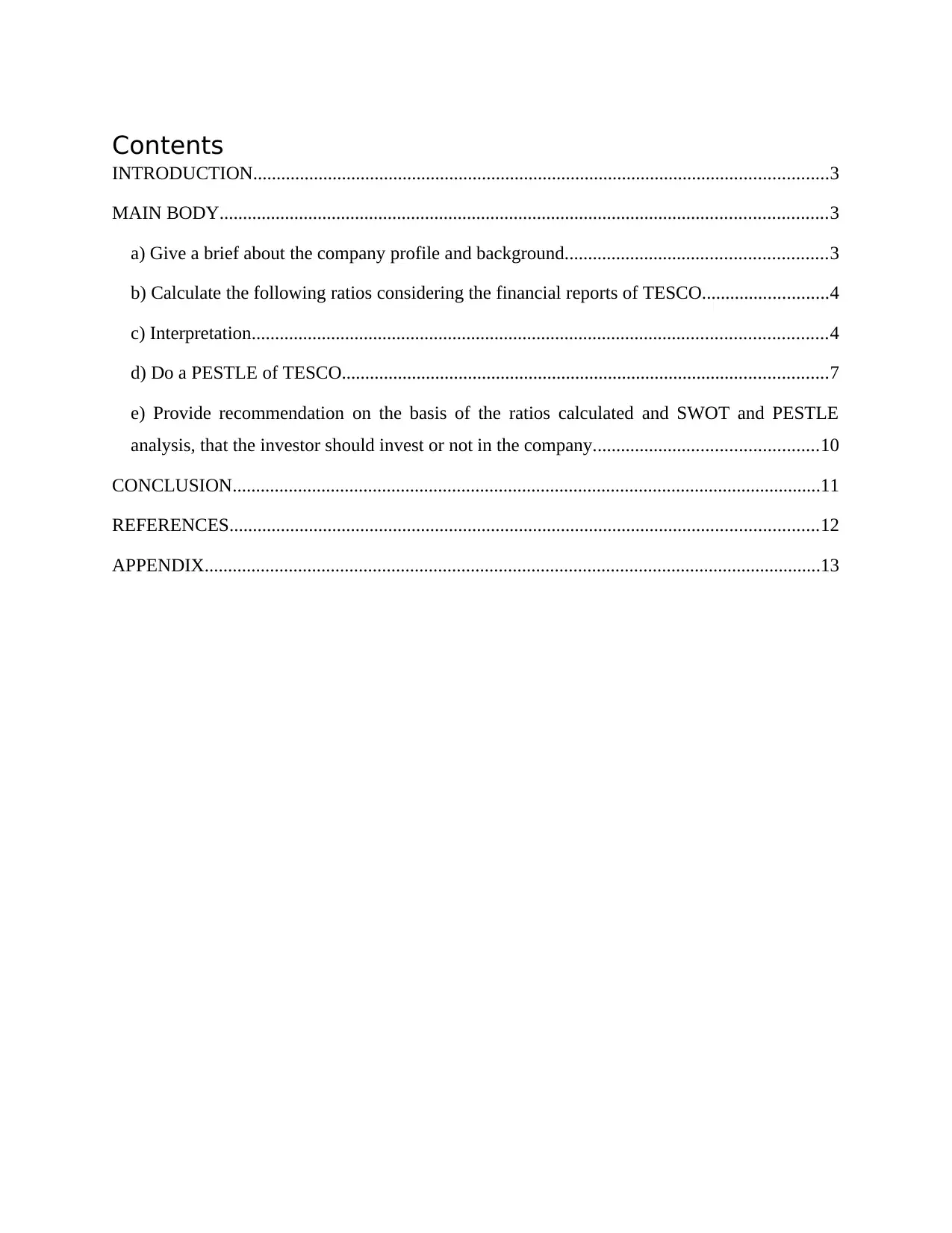
Contents
INTRODUCTION...........................................................................................................................3
MAIN BODY..................................................................................................................................3
a) Give a brief about the company profile and background........................................................3
b) Calculate the following ratios considering the financial reports of TESCO...........................4
c) Interpretation...........................................................................................................................4
d) Do a PESTLE of TESCO........................................................................................................7
e) Provide recommendation on the basis of the ratios calculated and SWOT and PESTLE
analysis, that the investor should invest or not in the company................................................10
CONCLUSION..............................................................................................................................11
REFERENCES..............................................................................................................................12
APPENDIX....................................................................................................................................13
INTRODUCTION...........................................................................................................................3
MAIN BODY..................................................................................................................................3
a) Give a brief about the company profile and background........................................................3
b) Calculate the following ratios considering the financial reports of TESCO...........................4
c) Interpretation...........................................................................................................................4
d) Do a PESTLE of TESCO........................................................................................................7
e) Provide recommendation on the basis of the ratios calculated and SWOT and PESTLE
analysis, that the investor should invest or not in the company................................................10
CONCLUSION..............................................................................................................................11
REFERENCES..............................................................................................................................12
APPENDIX....................................................................................................................................13
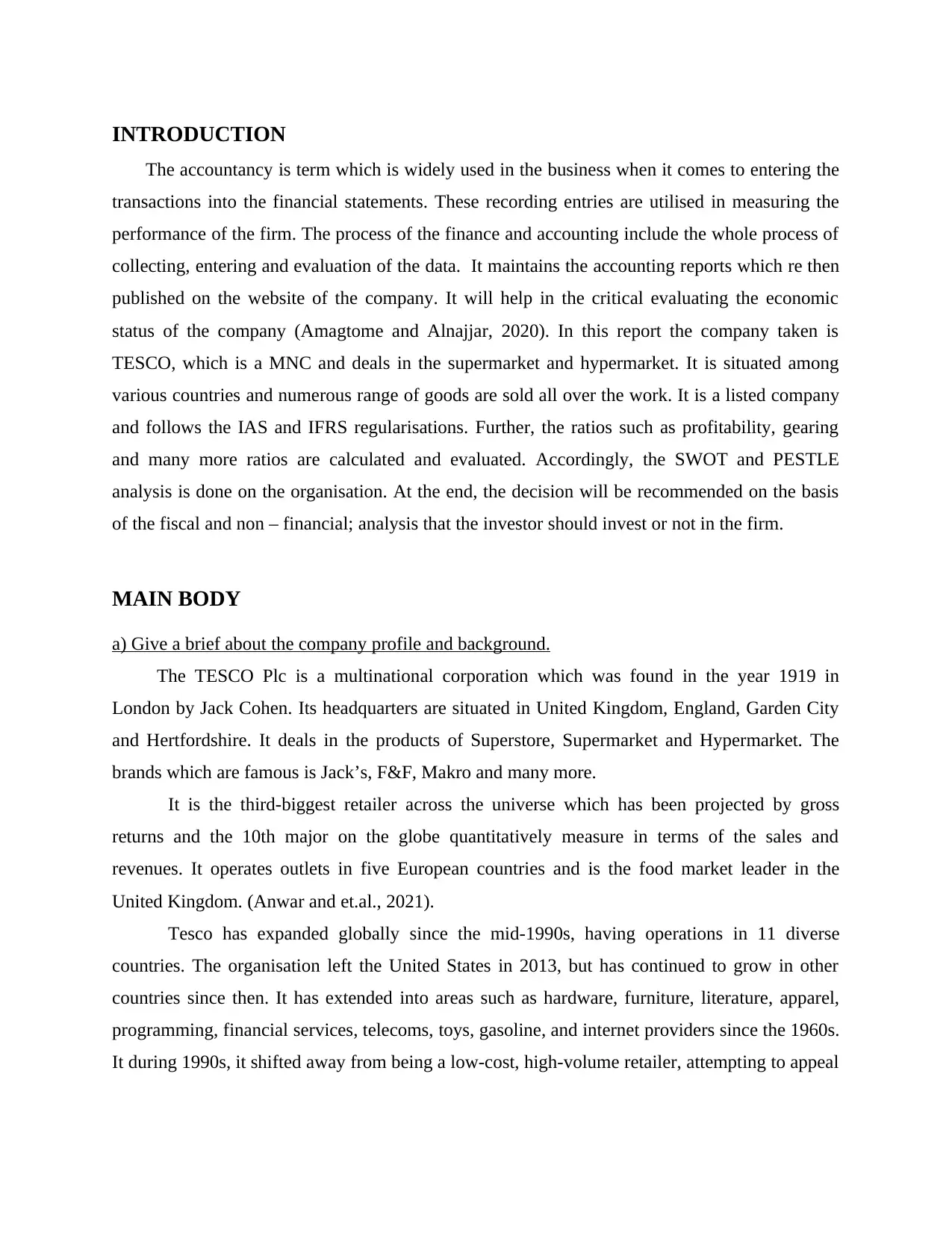
INTRODUCTION
The accountancy is term which is widely used in the business when it comes to entering the
transactions into the financial statements. These recording entries are utilised in measuring the
performance of the firm. The process of the finance and accounting include the whole process of
collecting, entering and evaluation of the data. It maintains the accounting reports which re then
published on the website of the company. It will help in the critical evaluating the economic
status of the company (Amagtome and Alnajjar, 2020). In this report the company taken is
TESCO, which is a MNC and deals in the supermarket and hypermarket. It is situated among
various countries and numerous range of goods are sold all over the work. It is a listed company
and follows the IAS and IFRS regularisations. Further, the ratios such as profitability, gearing
and many more ratios are calculated and evaluated. Accordingly, the SWOT and PESTLE
analysis is done on the organisation. At the end, the decision will be recommended on the basis
of the fiscal and non – financial; analysis that the investor should invest or not in the firm.
MAIN BODY
a) Give a brief about the company profile and background.
The TESCO Plc is a multinational corporation which was found in the year 1919 in
London by Jack Cohen. Its headquarters are situated in United Kingdom, England, Garden City
and Hertfordshire. It deals in the products of Superstore, Supermarket and Hypermarket. The
brands which are famous is Jack’s, F&F, Makro and many more.
It is the third-biggest retailer across the universe which has been projected by gross
returns and the 10th major on the globe quantitatively measure in terms of the sales and
revenues. It operates outlets in five European countries and is the food market leader in the
United Kingdom. (Anwar and et.al., 2021).
Tesco has expanded globally since the mid-1990s, having operations in 11 diverse
countries. The organisation left the United States in 2013, but has continued to grow in other
countries since then. It has extended into areas such as hardware, furniture, literature, apparel,
programming, financial services, telecoms, toys, gasoline, and internet providers since the 1960s.
It during 1990s, it shifted away from being a low-cost, high-volume retailer, attempting to appeal
The accountancy is term which is widely used in the business when it comes to entering the
transactions into the financial statements. These recording entries are utilised in measuring the
performance of the firm. The process of the finance and accounting include the whole process of
collecting, entering and evaluation of the data. It maintains the accounting reports which re then
published on the website of the company. It will help in the critical evaluating the economic
status of the company (Amagtome and Alnajjar, 2020). In this report the company taken is
TESCO, which is a MNC and deals in the supermarket and hypermarket. It is situated among
various countries and numerous range of goods are sold all over the work. It is a listed company
and follows the IAS and IFRS regularisations. Further, the ratios such as profitability, gearing
and many more ratios are calculated and evaluated. Accordingly, the SWOT and PESTLE
analysis is done on the organisation. At the end, the decision will be recommended on the basis
of the fiscal and non – financial; analysis that the investor should invest or not in the firm.
MAIN BODY
a) Give a brief about the company profile and background.
The TESCO Plc is a multinational corporation which was found in the year 1919 in
London by Jack Cohen. Its headquarters are situated in United Kingdom, England, Garden City
and Hertfordshire. It deals in the products of Superstore, Supermarket and Hypermarket. The
brands which are famous is Jack’s, F&F, Makro and many more.
It is the third-biggest retailer across the universe which has been projected by gross
returns and the 10th major on the globe quantitatively measure in terms of the sales and
revenues. It operates outlets in five European countries and is the food market leader in the
United Kingdom. (Anwar and et.al., 2021).
Tesco has expanded globally since the mid-1990s, having operations in 11 diverse
countries. The organisation left the United States in 2013, but has continued to grow in other
countries since then. It has extended into areas such as hardware, furniture, literature, apparel,
programming, financial services, telecoms, toys, gasoline, and internet providers since the 1960s.
It during 1990s, it shifted away from being a low-cost, high-volume retailer, attempting to appeal
⊘ This is a preview!⊘
Do you want full access?
Subscribe today to unlock all pages.

Trusted by 1+ million students worldwide
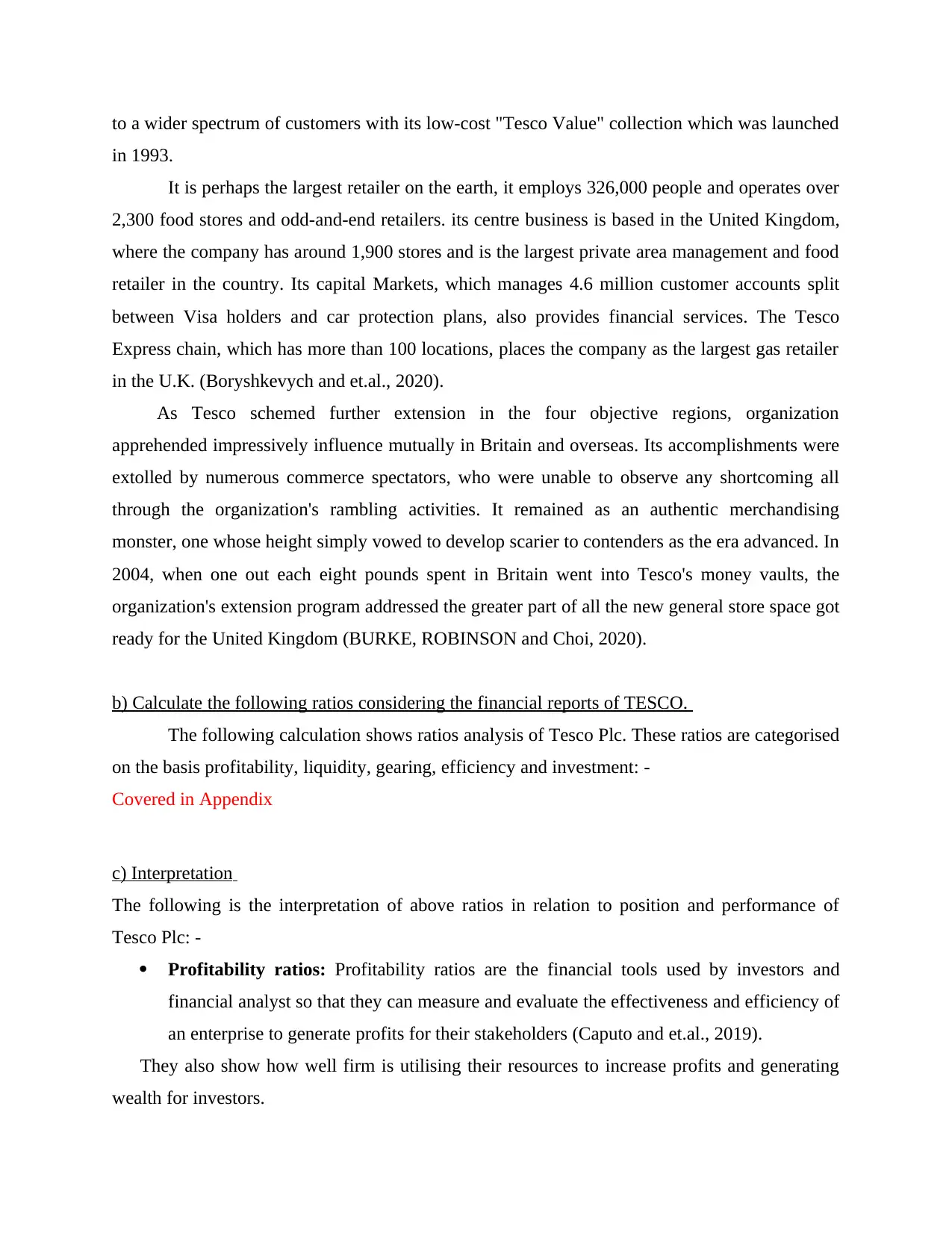
to a wider spectrum of customers with its low-cost "Tesco Value" collection which was launched
in 1993.
It is perhaps the largest retailer on the earth, it employs 326,000 people and operates over
2,300 food stores and odd-and-end retailers. its centre business is based in the United Kingdom,
where the company has around 1,900 stores and is the largest private area management and food
retailer in the country. Its capital Markets, which manages 4.6 million customer accounts split
between Visa holders and car protection plans, also provides financial services. The Tesco
Express chain, which has more than 100 locations, places the company as the largest gas retailer
in the U.K. (Boryshkevych and et.al., 2020).
As Tesco schemed further extension in the four objective regions, organization
apprehended impressively influence mutually in Britain and overseas. Its accomplishments were
extolled by numerous commerce spectators, who were unable to observe any shortcoming all
through the organization's rambling activities. It remained as an authentic merchandising
monster, one whose height simply vowed to develop scarier to contenders as the era advanced. In
2004, when one out each eight pounds spent in Britain went into Tesco's money vaults, the
organization's extension program addressed the greater part of all the new general store space got
ready for the United Kingdom (BURKE, ROBINSON and Choi, 2020).
b) Calculate the following ratios considering the financial reports of TESCO.
The following calculation shows ratios analysis of Tesco Plc. These ratios are categorised
on the basis profitability, liquidity, gearing, efficiency and investment: -
Covered in Appendix
c) Interpretation
The following is the interpretation of above ratios in relation to position and performance of
Tesco Plc: -
Profitability ratios: Profitability ratios are the financial tools used by investors and
financial analyst so that they can measure and evaluate the effectiveness and efficiency of
an enterprise to generate profits for their stakeholders (Caputo and et.al., 2019).
They also show how well firm is utilising their resources to increase profits and generating
wealth for investors.
in 1993.
It is perhaps the largest retailer on the earth, it employs 326,000 people and operates over
2,300 food stores and odd-and-end retailers. its centre business is based in the United Kingdom,
where the company has around 1,900 stores and is the largest private area management and food
retailer in the country. Its capital Markets, which manages 4.6 million customer accounts split
between Visa holders and car protection plans, also provides financial services. The Tesco
Express chain, which has more than 100 locations, places the company as the largest gas retailer
in the U.K. (Boryshkevych and et.al., 2020).
As Tesco schemed further extension in the four objective regions, organization
apprehended impressively influence mutually in Britain and overseas. Its accomplishments were
extolled by numerous commerce spectators, who were unable to observe any shortcoming all
through the organization's rambling activities. It remained as an authentic merchandising
monster, one whose height simply vowed to develop scarier to contenders as the era advanced. In
2004, when one out each eight pounds spent in Britain went into Tesco's money vaults, the
organization's extension program addressed the greater part of all the new general store space got
ready for the United Kingdom (BURKE, ROBINSON and Choi, 2020).
b) Calculate the following ratios considering the financial reports of TESCO.
The following calculation shows ratios analysis of Tesco Plc. These ratios are categorised
on the basis profitability, liquidity, gearing, efficiency and investment: -
Covered in Appendix
c) Interpretation
The following is the interpretation of above ratios in relation to position and performance of
Tesco Plc: -
Profitability ratios: Profitability ratios are the financial tools used by investors and
financial analyst so that they can measure and evaluate the effectiveness and efficiency of
an enterprise to generate profits for their stakeholders (Caputo and et.al., 2019).
They also show how well firm is utilising their resources to increase profits and generating
wealth for investors.
Paraphrase This Document
Need a fresh take? Get an instant paraphrase of this document with our AI Paraphraser
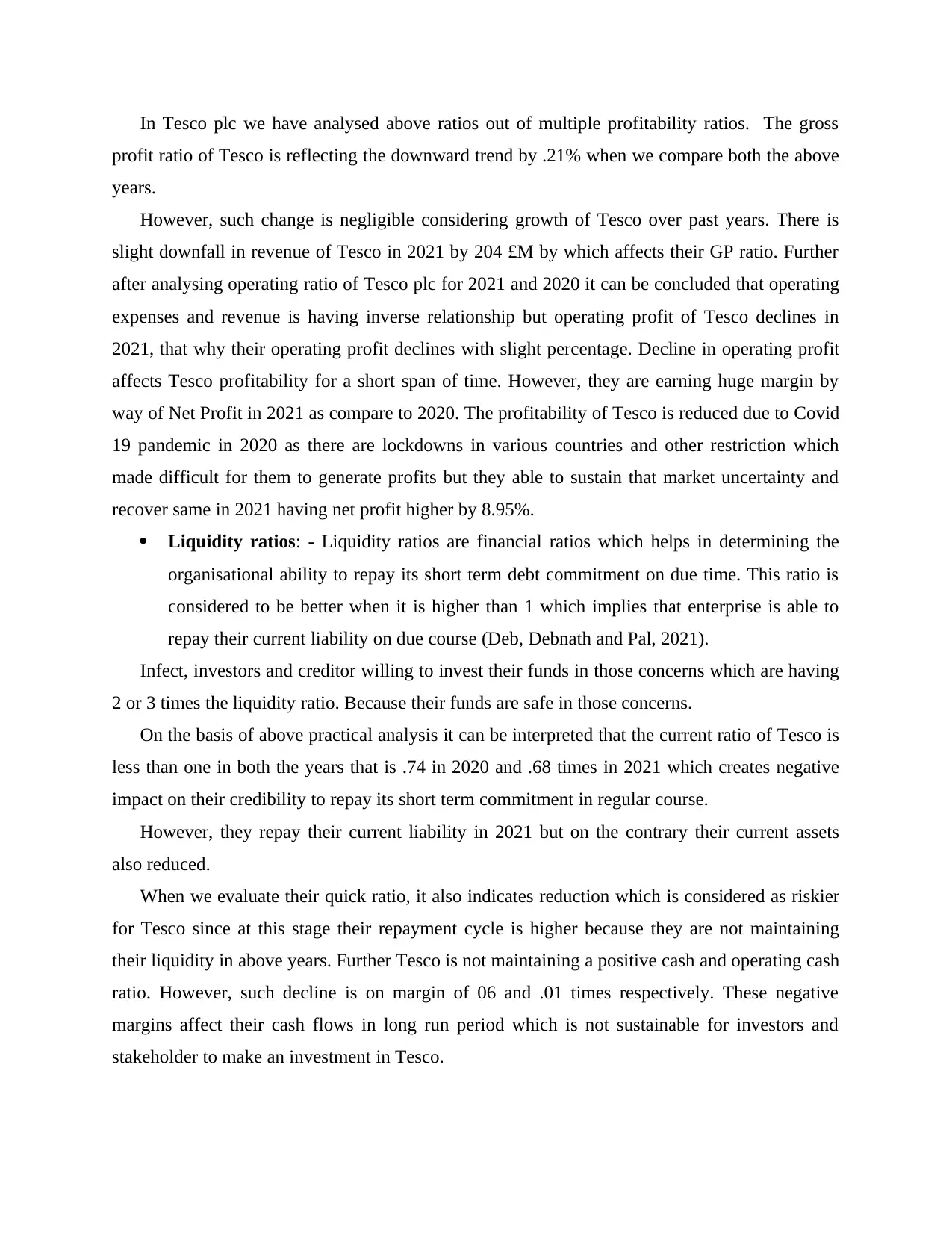
In Tesco plc we have analysed above ratios out of multiple profitability ratios. The gross
profit ratio of Tesco is reflecting the downward trend by .21% when we compare both the above
years.
However, such change is negligible considering growth of Tesco over past years. There is
slight downfall in revenue of Tesco in 2021 by 204 £M by which affects their GP ratio. Further
after analysing operating ratio of Tesco plc for 2021 and 2020 it can be concluded that operating
expenses and revenue is having inverse relationship but operating profit of Tesco declines in
2021, that why their operating profit declines with slight percentage. Decline in operating profit
affects Tesco profitability for a short span of time. However, they are earning huge margin by
way of Net Profit in 2021 as compare to 2020. The profitability of Tesco is reduced due to Covid
19 pandemic in 2020 as there are lockdowns in various countries and other restriction which
made difficult for them to generate profits but they able to sustain that market uncertainty and
recover same in 2021 having net profit higher by 8.95%.
Liquidity ratios: - Liquidity ratios are financial ratios which helps in determining the
organisational ability to repay its short term debt commitment on due time. This ratio is
considered to be better when it is higher than 1 which implies that enterprise is able to
repay their current liability on due course (Deb, Debnath and Pal, 2021).
Infect, investors and creditor willing to invest their funds in those concerns which are having
2 or 3 times the liquidity ratio. Because their funds are safe in those concerns.
On the basis of above practical analysis it can be interpreted that the current ratio of Tesco is
less than one in both the years that is .74 in 2020 and .68 times in 2021 which creates negative
impact on their credibility to repay its short term commitment in regular course.
However, they repay their current liability in 2021 but on the contrary their current assets
also reduced.
When we evaluate their quick ratio, it also indicates reduction which is considered as riskier
for Tesco since at this stage their repayment cycle is higher because they are not maintaining
their liquidity in above years. Further Tesco is not maintaining a positive cash and operating cash
ratio. However, such decline is on margin of 06 and .01 times respectively. These negative
margins affect their cash flows in long run period which is not sustainable for investors and
stakeholder to make an investment in Tesco.
profit ratio of Tesco is reflecting the downward trend by .21% when we compare both the above
years.
However, such change is negligible considering growth of Tesco over past years. There is
slight downfall in revenue of Tesco in 2021 by 204 £M by which affects their GP ratio. Further
after analysing operating ratio of Tesco plc for 2021 and 2020 it can be concluded that operating
expenses and revenue is having inverse relationship but operating profit of Tesco declines in
2021, that why their operating profit declines with slight percentage. Decline in operating profit
affects Tesco profitability for a short span of time. However, they are earning huge margin by
way of Net Profit in 2021 as compare to 2020. The profitability of Tesco is reduced due to Covid
19 pandemic in 2020 as there are lockdowns in various countries and other restriction which
made difficult for them to generate profits but they able to sustain that market uncertainty and
recover same in 2021 having net profit higher by 8.95%.
Liquidity ratios: - Liquidity ratios are financial ratios which helps in determining the
organisational ability to repay its short term debt commitment on due time. This ratio is
considered to be better when it is higher than 1 which implies that enterprise is able to
repay their current liability on due course (Deb, Debnath and Pal, 2021).
Infect, investors and creditor willing to invest their funds in those concerns which are having
2 or 3 times the liquidity ratio. Because their funds are safe in those concerns.
On the basis of above practical analysis it can be interpreted that the current ratio of Tesco is
less than one in both the years that is .74 in 2020 and .68 times in 2021 which creates negative
impact on their credibility to repay its short term commitment in regular course.
However, they repay their current liability in 2021 but on the contrary their current assets
also reduced.
When we evaluate their quick ratio, it also indicates reduction which is considered as riskier
for Tesco since at this stage their repayment cycle is higher because they are not maintaining
their liquidity in above years. Further Tesco is not maintaining a positive cash and operating cash
ratio. However, such decline is on margin of 06 and .01 times respectively. These negative
margins affect their cash flows in long run period which is not sustainable for investors and
stakeholder to make an investment in Tesco.
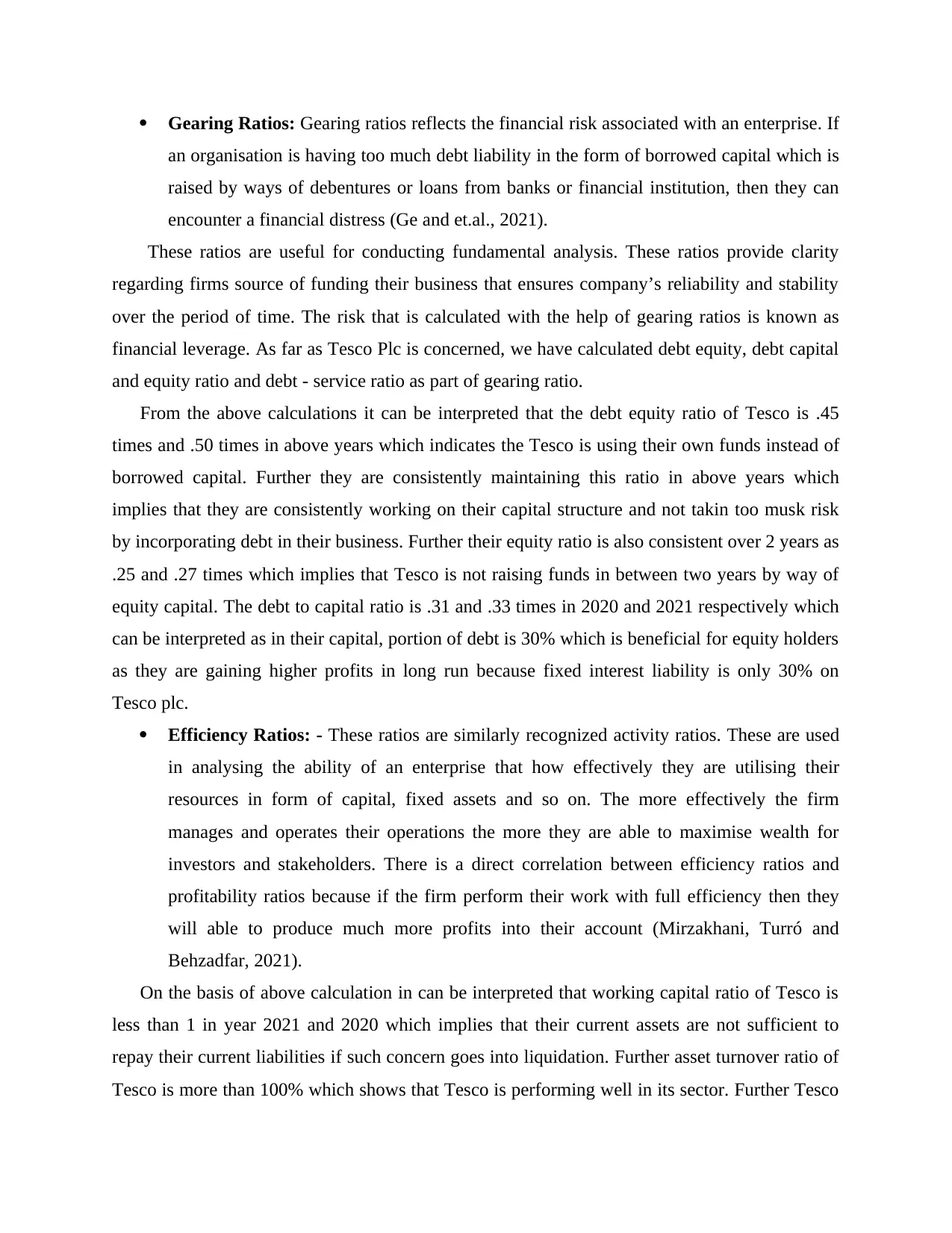
Gearing Ratios: Gearing ratios reflects the financial risk associated with an enterprise. If
an organisation is having too much debt liability in the form of borrowed capital which is
raised by ways of debentures or loans from banks or financial institution, then they can
encounter a financial distress (Ge and et.al., 2021).
These ratios are useful for conducting fundamental analysis. These ratios provide clarity
regarding firms source of funding their business that ensures company’s reliability and stability
over the period of time. The risk that is calculated with the help of gearing ratios is known as
financial leverage. As far as Tesco Plc is concerned, we have calculated debt equity, debt capital
and equity ratio and debt - service ratio as part of gearing ratio.
From the above calculations it can be interpreted that the debt equity ratio of Tesco is .45
times and .50 times in above years which indicates the Tesco is using their own funds instead of
borrowed capital. Further they are consistently maintaining this ratio in above years which
implies that they are consistently working on their capital structure and not takin too musk risk
by incorporating debt in their business. Further their equity ratio is also consistent over 2 years as
.25 and .27 times which implies that Tesco is not raising funds in between two years by way of
equity capital. The debt to capital ratio is .31 and .33 times in 2020 and 2021 respectively which
can be interpreted as in their capital, portion of debt is 30% which is beneficial for equity holders
as they are gaining higher profits in long run because fixed interest liability is only 30% on
Tesco plc.
Efficiency Ratios: - These ratios are similarly recognized activity ratios. These are used
in analysing the ability of an enterprise that how effectively they are utilising their
resources in form of capital, fixed assets and so on. The more effectively the firm
manages and operates their operations the more they are able to maximise wealth for
investors and stakeholders. There is a direct correlation between efficiency ratios and
profitability ratios because if the firm perform their work with full efficiency then they
will able to produce much more profits into their account (Mirzakhani, Turró and
Behzadfar, 2021).
On the basis of above calculation in can be interpreted that working capital ratio of Tesco is
less than 1 in year 2021 and 2020 which implies that their current assets are not sufficient to
repay their current liabilities if such concern goes into liquidation. Further asset turnover ratio of
Tesco is more than 100% which shows that Tesco is performing well in its sector. Further Tesco
an organisation is having too much debt liability in the form of borrowed capital which is
raised by ways of debentures or loans from banks or financial institution, then they can
encounter a financial distress (Ge and et.al., 2021).
These ratios are useful for conducting fundamental analysis. These ratios provide clarity
regarding firms source of funding their business that ensures company’s reliability and stability
over the period of time. The risk that is calculated with the help of gearing ratios is known as
financial leverage. As far as Tesco Plc is concerned, we have calculated debt equity, debt capital
and equity ratio and debt - service ratio as part of gearing ratio.
From the above calculations it can be interpreted that the debt equity ratio of Tesco is .45
times and .50 times in above years which indicates the Tesco is using their own funds instead of
borrowed capital. Further they are consistently maintaining this ratio in above years which
implies that they are consistently working on their capital structure and not takin too musk risk
by incorporating debt in their business. Further their equity ratio is also consistent over 2 years as
.25 and .27 times which implies that Tesco is not raising funds in between two years by way of
equity capital. The debt to capital ratio is .31 and .33 times in 2020 and 2021 respectively which
can be interpreted as in their capital, portion of debt is 30% which is beneficial for equity holders
as they are gaining higher profits in long run because fixed interest liability is only 30% on
Tesco plc.
Efficiency Ratios: - These ratios are similarly recognized activity ratios. These are used
in analysing the ability of an enterprise that how effectively they are utilising their
resources in form of capital, fixed assets and so on. The more effectively the firm
manages and operates their operations the more they are able to maximise wealth for
investors and stakeholders. There is a direct correlation between efficiency ratios and
profitability ratios because if the firm perform their work with full efficiency then they
will able to produce much more profits into their account (Mirzakhani, Turró and
Behzadfar, 2021).
On the basis of above calculation in can be interpreted that working capital ratio of Tesco is
less than 1 in year 2021 and 2020 which implies that their current assets are not sufficient to
repay their current liabilities if such concern goes into liquidation. Further asset turnover ratio of
Tesco is more than 100% which shows that Tesco is performing well in its sector. Further Tesco
⊘ This is a preview!⊘
Do you want full access?
Subscribe today to unlock all pages.

Trusted by 1+ million students worldwide
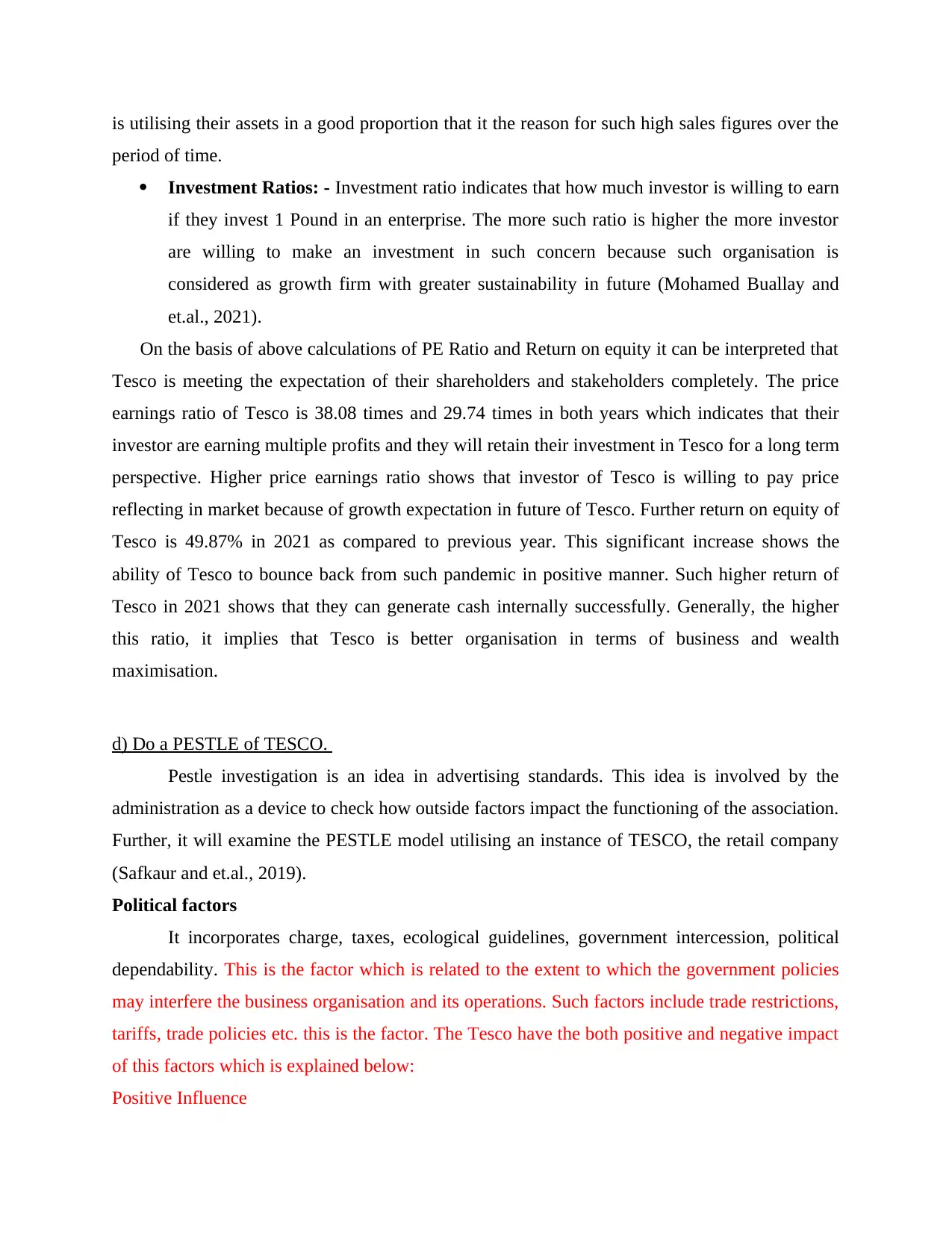
is utilising their assets in a good proportion that it the reason for such high sales figures over the
period of time.
Investment Ratios: - Investment ratio indicates that how much investor is willing to earn
if they invest 1 Pound in an enterprise. The more such ratio is higher the more investor
are willing to make an investment in such concern because such organisation is
considered as growth firm with greater sustainability in future (Mohamed Buallay and
et.al., 2021).
On the basis of above calculations of PE Ratio and Return on equity it can be interpreted that
Tesco is meeting the expectation of their shareholders and stakeholders completely. The price
earnings ratio of Tesco is 38.08 times and 29.74 times in both years which indicates that their
investor are earning multiple profits and they will retain their investment in Tesco for a long term
perspective. Higher price earnings ratio shows that investor of Tesco is willing to pay price
reflecting in market because of growth expectation in future of Tesco. Further return on equity of
Tesco is 49.87% in 2021 as compared to previous year. This significant increase shows the
ability of Tesco to bounce back from such pandemic in positive manner. Such higher return of
Tesco in 2021 shows that they can generate cash internally successfully. Generally, the higher
this ratio, it implies that Tesco is better organisation in terms of business and wealth
maximisation.
d) Do a PESTLE of TESCO.
Pestle investigation is an idea in advertising standards. This idea is involved by the
administration as a device to check how outside factors impact the functioning of the association.
Further, it will examine the PESTLE model utilising an instance of TESCO, the retail company
(Safkaur and et.al., 2019).
Political factors
It incorporates charge, taxes, ecological guidelines, government intercession, political
dependability. This is the factor which is related to the extent to which the government policies
may interfere the business organisation and its operations. Such factors include trade restrictions,
tariffs, trade policies etc. this is the factor. The Tesco have the both positive and negative impact
of this factors which is explained below:
Positive Influence
period of time.
Investment Ratios: - Investment ratio indicates that how much investor is willing to earn
if they invest 1 Pound in an enterprise. The more such ratio is higher the more investor
are willing to make an investment in such concern because such organisation is
considered as growth firm with greater sustainability in future (Mohamed Buallay and
et.al., 2021).
On the basis of above calculations of PE Ratio and Return on equity it can be interpreted that
Tesco is meeting the expectation of their shareholders and stakeholders completely. The price
earnings ratio of Tesco is 38.08 times and 29.74 times in both years which indicates that their
investor are earning multiple profits and they will retain their investment in Tesco for a long term
perspective. Higher price earnings ratio shows that investor of Tesco is willing to pay price
reflecting in market because of growth expectation in future of Tesco. Further return on equity of
Tesco is 49.87% in 2021 as compared to previous year. This significant increase shows the
ability of Tesco to bounce back from such pandemic in positive manner. Such higher return of
Tesco in 2021 shows that they can generate cash internally successfully. Generally, the higher
this ratio, it implies that Tesco is better organisation in terms of business and wealth
maximisation.
d) Do a PESTLE of TESCO.
Pestle investigation is an idea in advertising standards. This idea is involved by the
administration as a device to check how outside factors impact the functioning of the association.
Further, it will examine the PESTLE model utilising an instance of TESCO, the retail company
(Safkaur and et.al., 2019).
Political factors
It incorporates charge, taxes, ecological guidelines, government intercession, political
dependability. This is the factor which is related to the extent to which the government policies
may interfere the business organisation and its operations. Such factors include trade restrictions,
tariffs, trade policies etc. this is the factor. The Tesco have the both positive and negative impact
of this factors which is explained below:
Positive Influence
Paraphrase This Document
Need a fresh take? Get an instant paraphrase of this document with our AI Paraphraser
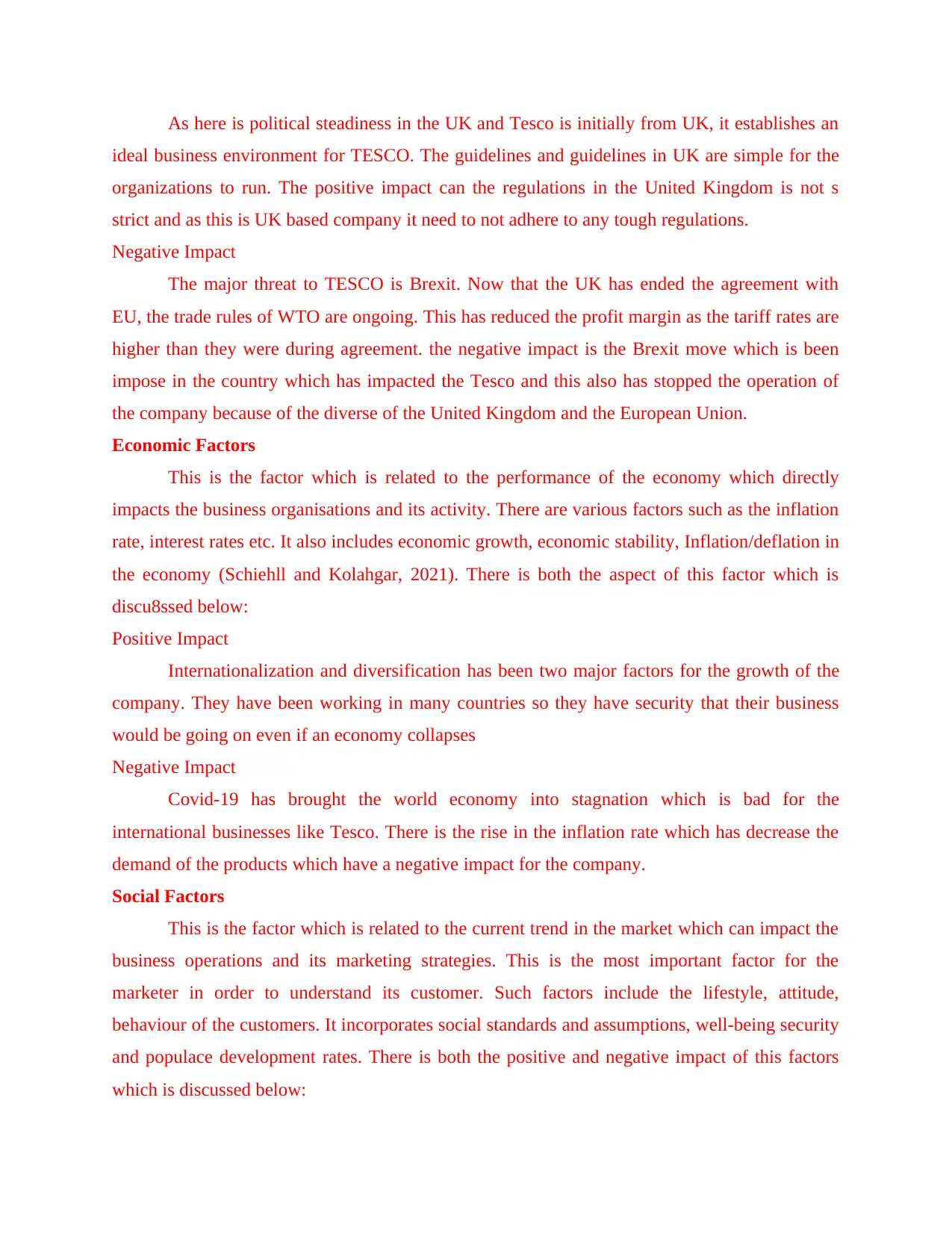
As here is political steadiness in the UK and Tesco is initially from UK, it establishes an
ideal business environment for TESCO. The guidelines and guidelines in UK are simple for the
organizations to run. The positive impact can the regulations in the United Kingdom is not s
strict and as this is UK based company it need to not adhere to any tough regulations.
Negative Impact
The major threat to TESCO is Brexit. Now that the UK has ended the agreement with
EU, the trade rules of WTO are ongoing. This has reduced the profit margin as the tariff rates are
higher than they were during agreement. the negative impact is the Brexit move which is been
impose in the country which has impacted the Tesco and this also has stopped the operation of
the company because of the diverse of the United Kingdom and the European Union.
Economic Factors
This is the factor which is related to the performance of the economy which directly
impacts the business organisations and its activity. There are various factors such as the inflation
rate, interest rates etc. It also includes economic growth, economic stability, Inflation/deflation in
the economy (Schiehll and Kolahgar, 2021). There is both the aspect of this factor which is
discu8ssed below:
Positive Impact
Internationalization and diversification has been two major factors for the growth of the
company. They have been working in many countries so they have security that their business
would be going on even if an economy collapses
Negative Impact
Covid-19 has brought the world economy into stagnation which is bad for the
international businesses like Tesco. There is the rise in the inflation rate which has decrease the
demand of the products which have a negative impact for the company.
Social Factors
This is the factor which is related to the current trend in the market which can impact the
business operations and its marketing strategies. This is the most important factor for the
marketer in order to understand its customer. Such factors include the lifestyle, attitude,
behaviour of the customers. It incorporates social standards and assumptions, well-being security
and populace development rates. There is both the positive and negative impact of this factors
which is discussed below:
ideal business environment for TESCO. The guidelines and guidelines in UK are simple for the
organizations to run. The positive impact can the regulations in the United Kingdom is not s
strict and as this is UK based company it need to not adhere to any tough regulations.
Negative Impact
The major threat to TESCO is Brexit. Now that the UK has ended the agreement with
EU, the trade rules of WTO are ongoing. This has reduced the profit margin as the tariff rates are
higher than they were during agreement. the negative impact is the Brexit move which is been
impose in the country which has impacted the Tesco and this also has stopped the operation of
the company because of the diverse of the United Kingdom and the European Union.
Economic Factors
This is the factor which is related to the performance of the economy which directly
impacts the business organisations and its activity. There are various factors such as the inflation
rate, interest rates etc. It also includes economic growth, economic stability, Inflation/deflation in
the economy (Schiehll and Kolahgar, 2021). There is both the aspect of this factor which is
discu8ssed below:
Positive Impact
Internationalization and diversification has been two major factors for the growth of the
company. They have been working in many countries so they have security that their business
would be going on even if an economy collapses
Negative Impact
Covid-19 has brought the world economy into stagnation which is bad for the
international businesses like Tesco. There is the rise in the inflation rate which has decrease the
demand of the products which have a negative impact for the company.
Social Factors
This is the factor which is related to the current trend in the market which can impact the
business operations and its marketing strategies. This is the most important factor for the
marketer in order to understand its customer. Such factors include the lifestyle, attitude,
behaviour of the customers. It incorporates social standards and assumptions, well-being security
and populace development rates. There is both the positive and negative impact of this factors
which is discussed below:
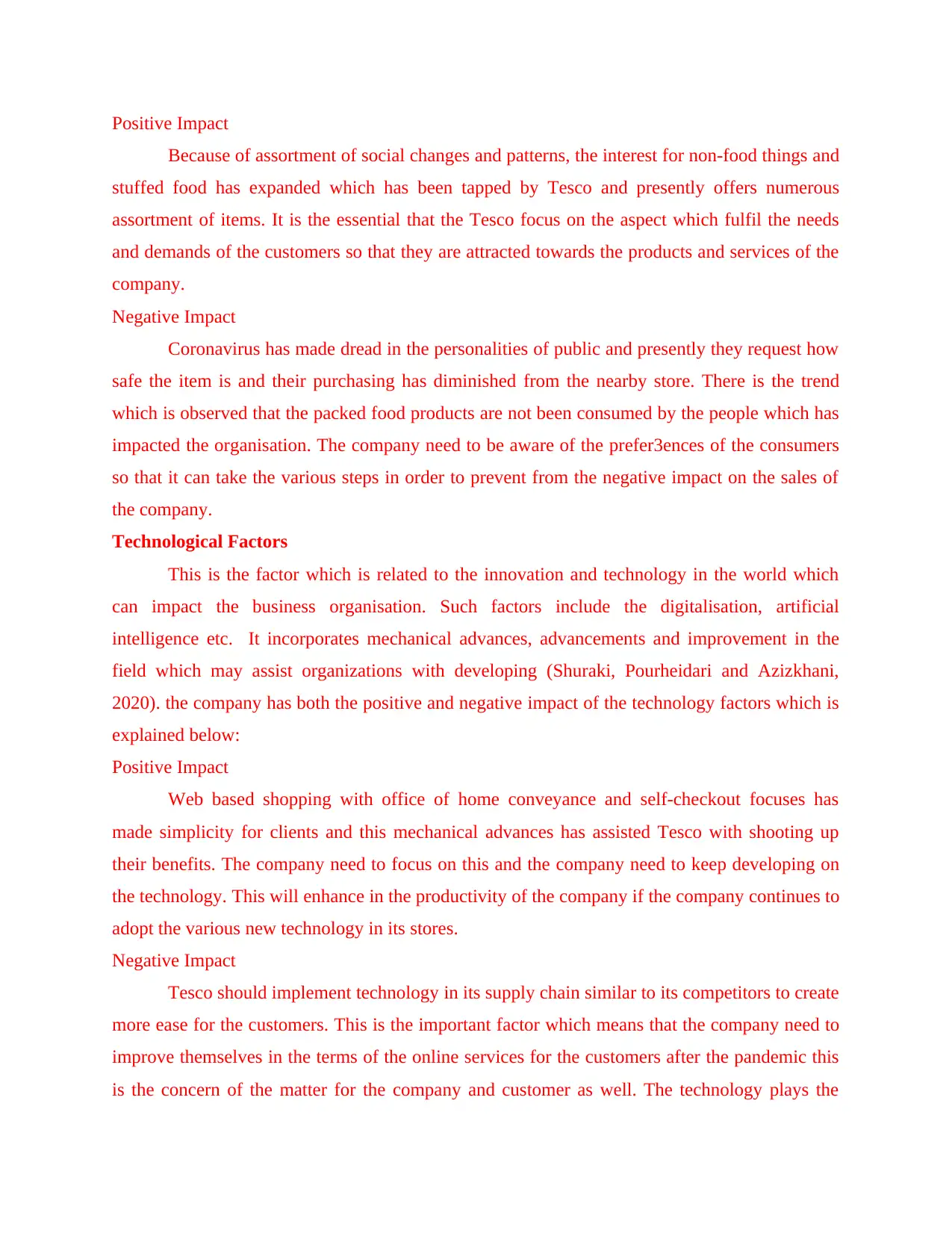
Positive Impact
Because of assortment of social changes and patterns, the interest for non-food things and
stuffed food has expanded which has been tapped by Tesco and presently offers numerous
assortment of items. It is the essential that the Tesco focus on the aspect which fulfil the needs
and demands of the customers so that they are attracted towards the products and services of the
company.
Negative Impact
Coronavirus has made dread in the personalities of public and presently they request how
safe the item is and their purchasing has diminished from the nearby store. There is the trend
which is observed that the packed food products are not been consumed by the people which has
impacted the organisation. The company need to be aware of the prefer3ences of the consumers
so that it can take the various steps in order to prevent from the negative impact on the sales of
the company.
Technological Factors
This is the factor which is related to the innovation and technology in the world which
can impact the business organisation. Such factors include the digitalisation, artificial
intelligence etc. It incorporates mechanical advances, advancements and improvement in the
field which may assist organizations with developing (Shuraki, Pourheidari and Azizkhani,
2020). the company has both the positive and negative impact of the technology factors which is
explained below:
Positive Impact
Web based shopping with office of home conveyance and self-checkout focuses has
made simplicity for clients and this mechanical advances has assisted Tesco with shooting up
their benefits. The company need to focus on this and the company need to keep developing on
the technology. This will enhance in the productivity of the company if the company continues to
adopt the various new technology in its stores.
Negative Impact
Tesco should implement technology in its supply chain similar to its competitors to create
more ease for the customers. This is the important factor which means that the company need to
improve themselves in the terms of the online services for the customers after the pandemic this
is the concern of the matter for the company and customer as well. The technology plays the
Because of assortment of social changes and patterns, the interest for non-food things and
stuffed food has expanded which has been tapped by Tesco and presently offers numerous
assortment of items. It is the essential that the Tesco focus on the aspect which fulfil the needs
and demands of the customers so that they are attracted towards the products and services of the
company.
Negative Impact
Coronavirus has made dread in the personalities of public and presently they request how
safe the item is and their purchasing has diminished from the nearby store. There is the trend
which is observed that the packed food products are not been consumed by the people which has
impacted the organisation. The company need to be aware of the prefer3ences of the consumers
so that it can take the various steps in order to prevent from the negative impact on the sales of
the company.
Technological Factors
This is the factor which is related to the innovation and technology in the world which
can impact the business organisation. Such factors include the digitalisation, artificial
intelligence etc. It incorporates mechanical advances, advancements and improvement in the
field which may assist organizations with developing (Shuraki, Pourheidari and Azizkhani,
2020). the company has both the positive and negative impact of the technology factors which is
explained below:
Positive Impact
Web based shopping with office of home conveyance and self-checkout focuses has
made simplicity for clients and this mechanical advances has assisted Tesco with shooting up
their benefits. The company need to focus on this and the company need to keep developing on
the technology. This will enhance in the productivity of the company if the company continues to
adopt the various new technology in its stores.
Negative Impact
Tesco should implement technology in its supply chain similar to its competitors to create
more ease for the customers. This is the important factor which means that the company need to
improve themselves in the terms of the online services for the customers after the pandemic this
is the concern of the matter for the company and customer as well. The technology plays the
⊘ This is a preview!⊘
Do you want full access?
Subscribe today to unlock all pages.

Trusted by 1+ million students worldwide
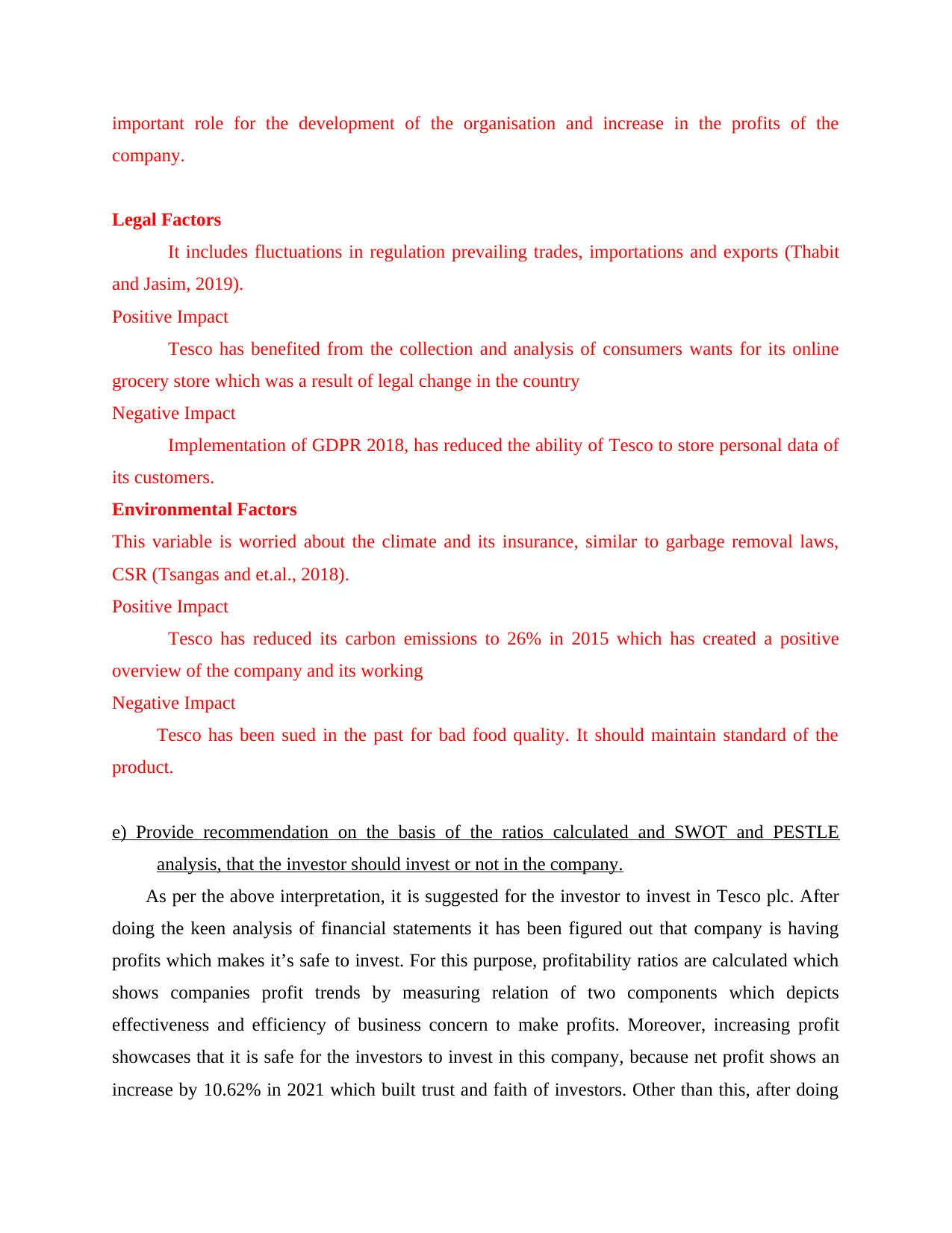
important role for the development of the organisation and increase in the profits of the
company.
Legal Factors
It includes fluctuations in regulation prevailing trades, importations and exports (Thabit
and Jasim, 2019).
Positive Impact
Tesco has benefited from the collection and analysis of consumers wants for its online
grocery store which was a result of legal change in the country
Negative Impact
Implementation of GDPR 2018, has reduced the ability of Tesco to store personal data of
its customers.
Environmental Factors
This variable is worried about the climate and its insurance, similar to garbage removal laws,
CSR (Tsangas and et.al., 2018).
Positive Impact
Tesco has reduced its carbon emissions to 26% in 2015 which has created a positive
overview of the company and its working
Negative Impact
Tesco has been sued in the past for bad food quality. It should maintain standard of the
product.
e) Provide recommendation on the basis of the ratios calculated and SWOT and PESTLE
analysis, that the investor should invest or not in the company.
As per the above interpretation, it is suggested for the investor to invest in Tesco plc. After
doing the keen analysis of financial statements it has been figured out that company is having
profits which makes it’s safe to invest. For this purpose, profitability ratios are calculated which
shows companies profit trends by measuring relation of two components which depicts
effectiveness and efficiency of business concern to make profits. Moreover, increasing profit
showcases that it is safe for the investors to invest in this company, because net profit shows an
increase by 10.62% in 2021 which built trust and faith of investors. Other than this, after doing
company.
Legal Factors
It includes fluctuations in regulation prevailing trades, importations and exports (Thabit
and Jasim, 2019).
Positive Impact
Tesco has benefited from the collection and analysis of consumers wants for its online
grocery store which was a result of legal change in the country
Negative Impact
Implementation of GDPR 2018, has reduced the ability of Tesco to store personal data of
its customers.
Environmental Factors
This variable is worried about the climate and its insurance, similar to garbage removal laws,
CSR (Tsangas and et.al., 2018).
Positive Impact
Tesco has reduced its carbon emissions to 26% in 2015 which has created a positive
overview of the company and its working
Negative Impact
Tesco has been sued in the past for bad food quality. It should maintain standard of the
product.
e) Provide recommendation on the basis of the ratios calculated and SWOT and PESTLE
analysis, that the investor should invest or not in the company.
As per the above interpretation, it is suggested for the investor to invest in Tesco plc. After
doing the keen analysis of financial statements it has been figured out that company is having
profits which makes it’s safe to invest. For this purpose, profitability ratios are calculated which
shows companies profit trends by measuring relation of two components which depicts
effectiveness and efficiency of business concern to make profits. Moreover, increasing profit
showcases that it is safe for the investors to invest in this company, because net profit shows an
increase by 10.62% in 2021 which built trust and faith of investors. Other than this, after doing
Paraphrase This Document
Need a fresh take? Get an instant paraphrase of this document with our AI Paraphraser
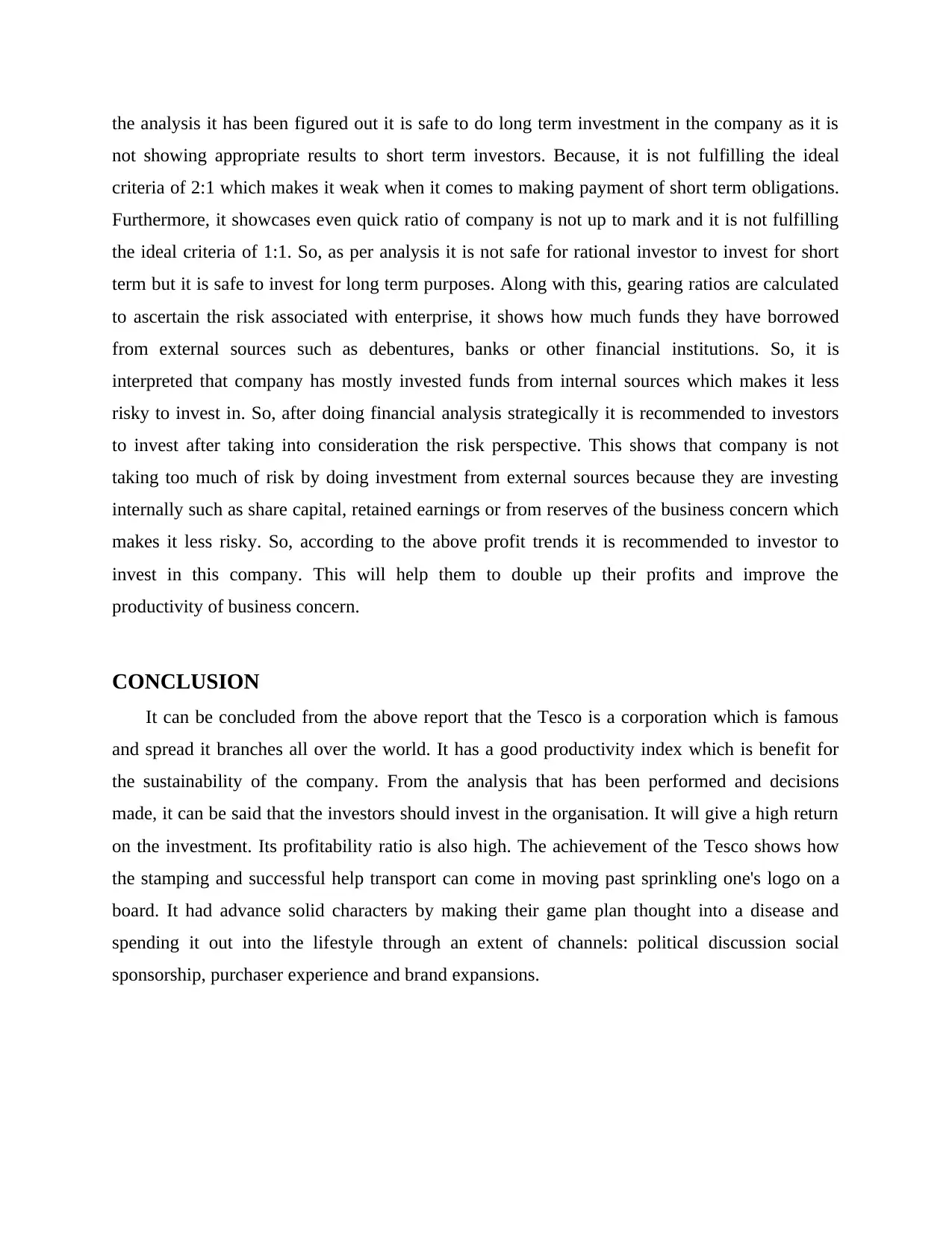
the analysis it has been figured out it is safe to do long term investment in the company as it is
not showing appropriate results to short term investors. Because, it is not fulfilling the ideal
criteria of 2:1 which makes it weak when it comes to making payment of short term obligations.
Furthermore, it showcases even quick ratio of company is not up to mark and it is not fulfilling
the ideal criteria of 1:1. So, as per analysis it is not safe for rational investor to invest for short
term but it is safe to invest for long term purposes. Along with this, gearing ratios are calculated
to ascertain the risk associated with enterprise, it shows how much funds they have borrowed
from external sources such as debentures, banks or other financial institutions. So, it is
interpreted that company has mostly invested funds from internal sources which makes it less
risky to invest in. So, after doing financial analysis strategically it is recommended to investors
to invest after taking into consideration the risk perspective. This shows that company is not
taking too much of risk by doing investment from external sources because they are investing
internally such as share capital, retained earnings or from reserves of the business concern which
makes it less risky. So, according to the above profit trends it is recommended to investor to
invest in this company. This will help them to double up their profits and improve the
productivity of business concern.
CONCLUSION
It can be concluded from the above report that the Tesco is a corporation which is famous
and spread it branches all over the world. It has a good productivity index which is benefit for
the sustainability of the company. From the analysis that has been performed and decisions
made, it can be said that the investors should invest in the organisation. It will give a high return
on the investment. Its profitability ratio is also high. The achievement of the Tesco shows how
the stamping and successful help transport can come in moving past sprinkling one's logo on a
board. It had advance solid characters by making their game plan thought into a disease and
spending it out into the lifestyle through an extent of channels: political discussion social
sponsorship, purchaser experience and brand expansions.
not showing appropriate results to short term investors. Because, it is not fulfilling the ideal
criteria of 2:1 which makes it weak when it comes to making payment of short term obligations.
Furthermore, it showcases even quick ratio of company is not up to mark and it is not fulfilling
the ideal criteria of 1:1. So, as per analysis it is not safe for rational investor to invest for short
term but it is safe to invest for long term purposes. Along with this, gearing ratios are calculated
to ascertain the risk associated with enterprise, it shows how much funds they have borrowed
from external sources such as debentures, banks or other financial institutions. So, it is
interpreted that company has mostly invested funds from internal sources which makes it less
risky to invest in. So, after doing financial analysis strategically it is recommended to investors
to invest after taking into consideration the risk perspective. This shows that company is not
taking too much of risk by doing investment from external sources because they are investing
internally such as share capital, retained earnings or from reserves of the business concern which
makes it less risky. So, according to the above profit trends it is recommended to investor to
invest in this company. This will help them to double up their profits and improve the
productivity of business concern.
CONCLUSION
It can be concluded from the above report that the Tesco is a corporation which is famous
and spread it branches all over the world. It has a good productivity index which is benefit for
the sustainability of the company. From the analysis that has been performed and decisions
made, it can be said that the investors should invest in the organisation. It will give a high return
on the investment. Its profitability ratio is also high. The achievement of the Tesco shows how
the stamping and successful help transport can come in moving past sprinkling one's logo on a
board. It had advance solid characters by making their game plan thought into a disease and
spending it out into the lifestyle through an extent of channels: political discussion social
sponsorship, purchaser experience and brand expansions.
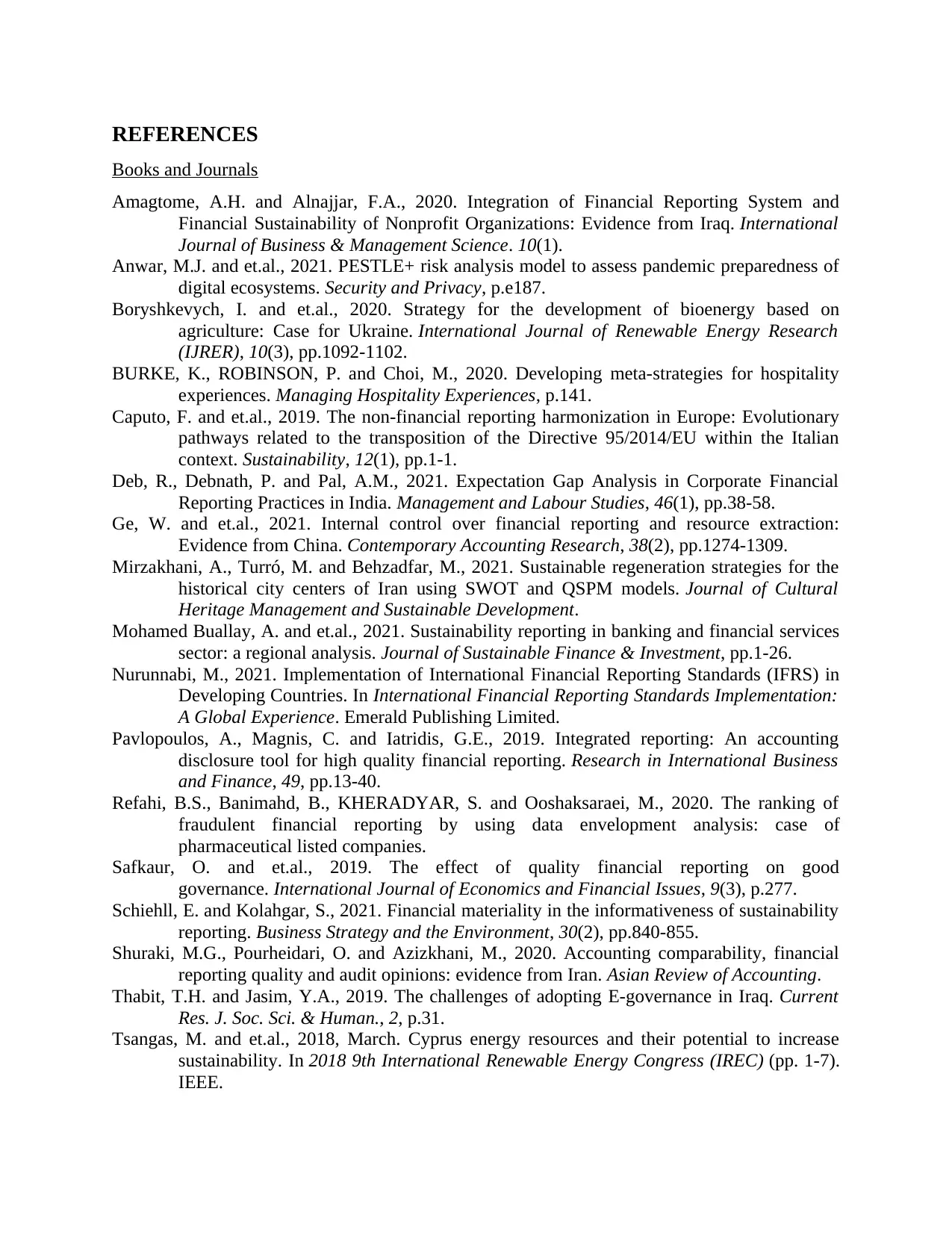
REFERENCES
Books and Journals
Amagtome, A.H. and Alnajjar, F.A., 2020. Integration of Financial Reporting System and
Financial Sustainability of Nonprofit Organizations: Evidence from Iraq. International
Journal of Business & Management Science. 10(1).
Anwar, M.J. and et.al., 2021. PESTLE+ risk analysis model to assess pandemic preparedness of
digital ecosystems. Security and Privacy, p.e187.
Boryshkevych, I. and et.al., 2020. Strategy for the development of bioenergy based on
agriculture: Case for Ukraine. International Journal of Renewable Energy Research
(IJRER), 10(3), pp.1092-1102.
BURKE, K., ROBINSON, P. and Choi, M., 2020. Developing meta-strategies for hospitality
experiences. Managing Hospitality Experiences, p.141.
Caputo, F. and et.al., 2019. The non-financial reporting harmonization in Europe: Evolutionary
pathways related to the transposition of the Directive 95/2014/EU within the Italian
context. Sustainability, 12(1), pp.1-1.
Deb, R., Debnath, P. and Pal, A.M., 2021. Expectation Gap Analysis in Corporate Financial
Reporting Practices in India. Management and Labour Studies, 46(1), pp.38-58.
Ge, W. and et.al., 2021. Internal control over financial reporting and resource extraction:
Evidence from China. Contemporary Accounting Research, 38(2), pp.1274-1309.
Mirzakhani, A., Turró, M. and Behzadfar, M., 2021. Sustainable regeneration strategies for the
historical city centers of Iran using SWOT and QSPM models. Journal of Cultural
Heritage Management and Sustainable Development.
Mohamed Buallay, A. and et.al., 2021. Sustainability reporting in banking and financial services
sector: a regional analysis. Journal of Sustainable Finance & Investment, pp.1-26.
Nurunnabi, M., 2021. Implementation of International Financial Reporting Standards (IFRS) in
Developing Countries. In International Financial Reporting Standards Implementation:
A Global Experience. Emerald Publishing Limited.
Pavlopoulos, A., Magnis, C. and Iatridis, G.E., 2019. Integrated reporting: An accounting
disclosure tool for high quality financial reporting. Research in International Business
and Finance, 49, pp.13-40.
Refahi, B.S., Banimahd, B., KHERADYAR, S. and Ooshaksaraei, M., 2020. The ranking of
fraudulent financial reporting by using data envelopment analysis: case of
pharmaceutical listed companies.
Safkaur, O. and et.al., 2019. The effect of quality financial reporting on good
governance. International Journal of Economics and Financial Issues, 9(3), p.277.
Schiehll, E. and Kolahgar, S., 2021. Financial materiality in the informativeness of sustainability
reporting. Business Strategy and the Environment, 30(2), pp.840-855.
Shuraki, M.G., Pourheidari, O. and Azizkhani, M., 2020. Accounting comparability, financial
reporting quality and audit opinions: evidence from Iran. Asian Review of Accounting.
Thabit, T.H. and Jasim, Y.A., 2019. The challenges of adopting E-governance in Iraq. Current
Res. J. Soc. Sci. & Human., 2, p.31.
Tsangas, M. and et.al., 2018, March. Cyprus energy resources and their potential to increase
sustainability. In 2018 9th International Renewable Energy Congress (IREC) (pp. 1-7).
IEEE.
Books and Journals
Amagtome, A.H. and Alnajjar, F.A., 2020. Integration of Financial Reporting System and
Financial Sustainability of Nonprofit Organizations: Evidence from Iraq. International
Journal of Business & Management Science. 10(1).
Anwar, M.J. and et.al., 2021. PESTLE+ risk analysis model to assess pandemic preparedness of
digital ecosystems. Security and Privacy, p.e187.
Boryshkevych, I. and et.al., 2020. Strategy for the development of bioenergy based on
agriculture: Case for Ukraine. International Journal of Renewable Energy Research
(IJRER), 10(3), pp.1092-1102.
BURKE, K., ROBINSON, P. and Choi, M., 2020. Developing meta-strategies for hospitality
experiences. Managing Hospitality Experiences, p.141.
Caputo, F. and et.al., 2019. The non-financial reporting harmonization in Europe: Evolutionary
pathways related to the transposition of the Directive 95/2014/EU within the Italian
context. Sustainability, 12(1), pp.1-1.
Deb, R., Debnath, P. and Pal, A.M., 2021. Expectation Gap Analysis in Corporate Financial
Reporting Practices in India. Management and Labour Studies, 46(1), pp.38-58.
Ge, W. and et.al., 2021. Internal control over financial reporting and resource extraction:
Evidence from China. Contemporary Accounting Research, 38(2), pp.1274-1309.
Mirzakhani, A., Turró, M. and Behzadfar, M., 2021. Sustainable regeneration strategies for the
historical city centers of Iran using SWOT and QSPM models. Journal of Cultural
Heritage Management and Sustainable Development.
Mohamed Buallay, A. and et.al., 2021. Sustainability reporting in banking and financial services
sector: a regional analysis. Journal of Sustainable Finance & Investment, pp.1-26.
Nurunnabi, M., 2021. Implementation of International Financial Reporting Standards (IFRS) in
Developing Countries. In International Financial Reporting Standards Implementation:
A Global Experience. Emerald Publishing Limited.
Pavlopoulos, A., Magnis, C. and Iatridis, G.E., 2019. Integrated reporting: An accounting
disclosure tool for high quality financial reporting. Research in International Business
and Finance, 49, pp.13-40.
Refahi, B.S., Banimahd, B., KHERADYAR, S. and Ooshaksaraei, M., 2020. The ranking of
fraudulent financial reporting by using data envelopment analysis: case of
pharmaceutical listed companies.
Safkaur, O. and et.al., 2019. The effect of quality financial reporting on good
governance. International Journal of Economics and Financial Issues, 9(3), p.277.
Schiehll, E. and Kolahgar, S., 2021. Financial materiality in the informativeness of sustainability
reporting. Business Strategy and the Environment, 30(2), pp.840-855.
Shuraki, M.G., Pourheidari, O. and Azizkhani, M., 2020. Accounting comparability, financial
reporting quality and audit opinions: evidence from Iran. Asian Review of Accounting.
Thabit, T.H. and Jasim, Y.A., 2019. The challenges of adopting E-governance in Iraq. Current
Res. J. Soc. Sci. & Human., 2, p.31.
Tsangas, M. and et.al., 2018, March. Cyprus energy resources and their potential to increase
sustainability. In 2018 9th International Renewable Energy Congress (IREC) (pp. 1-7).
IEEE.
⊘ This is a preview!⊘
Do you want full access?
Subscribe today to unlock all pages.

Trusted by 1+ million students worldwide

APPENDIX
Calculation of various Ratios:
Profitability ratios
Gross Profit Ratio = (Gross Profit / Net Sales * 100)
2020 = (4098 / 58091 * 100) = 7.05%
2021 = (3965 / 57887 * 100) = 6.84%
Operating Ratio = (Operating Expenses / Net Sales * 100)
2020 = (1892 / 58091 * 100) = 3.26 %
2021 = (2229 / 57887 * 100) = 3.85 %
Operating Profit Ratio = (Operating Profit / Net Sales) * 100
2020 = (2206 / 58091 * 100) = 3.80 %
2021 = (1736 / 57887 * 100) = 3.0 %
Net Profit Ratio = Net Profit / Total Revenue * 100
2020 = (973 / 58091 * 100) = 1.67 %
2021 = (6147 / 57887 * 100) = 10.62 %
Liquidity Ratio
Current Ratio = (Current Assets / Current Liabilities)
2020 = (13893/18656) = .74 times
2021 = (10807/15997) = .68 times
Quick Ratio = (Current Assets - Inventories) / Current Liabilities
2020 = (13893 - 2433 / 18656) = 0.61 times
2021 = (10807 - 2069 / 15997) = 0.55 times
Cash Ratio = (Cash + Marketable Securities) / Current Liabilities
Calculation of various Ratios:
Profitability ratios
Gross Profit Ratio = (Gross Profit / Net Sales * 100)
2020 = (4098 / 58091 * 100) = 7.05%
2021 = (3965 / 57887 * 100) = 6.84%
Operating Ratio = (Operating Expenses / Net Sales * 100)
2020 = (1892 / 58091 * 100) = 3.26 %
2021 = (2229 / 57887 * 100) = 3.85 %
Operating Profit Ratio = (Operating Profit / Net Sales) * 100
2020 = (2206 / 58091 * 100) = 3.80 %
2021 = (1736 / 57887 * 100) = 3.0 %
Net Profit Ratio = Net Profit / Total Revenue * 100
2020 = (973 / 58091 * 100) = 1.67 %
2021 = (6147 / 57887 * 100) = 10.62 %
Liquidity Ratio
Current Ratio = (Current Assets / Current Liabilities)
2020 = (13893/18656) = .74 times
2021 = (10807/15997) = .68 times
Quick Ratio = (Current Assets - Inventories) / Current Liabilities
2020 = (13893 - 2433 / 18656) = 0.61 times
2021 = (10807 - 2069 / 15997) = 0.55 times
Cash Ratio = (Cash + Marketable Securities) / Current Liabilities
Paraphrase This Document
Need a fresh take? Get an instant paraphrase of this document with our AI Paraphraser
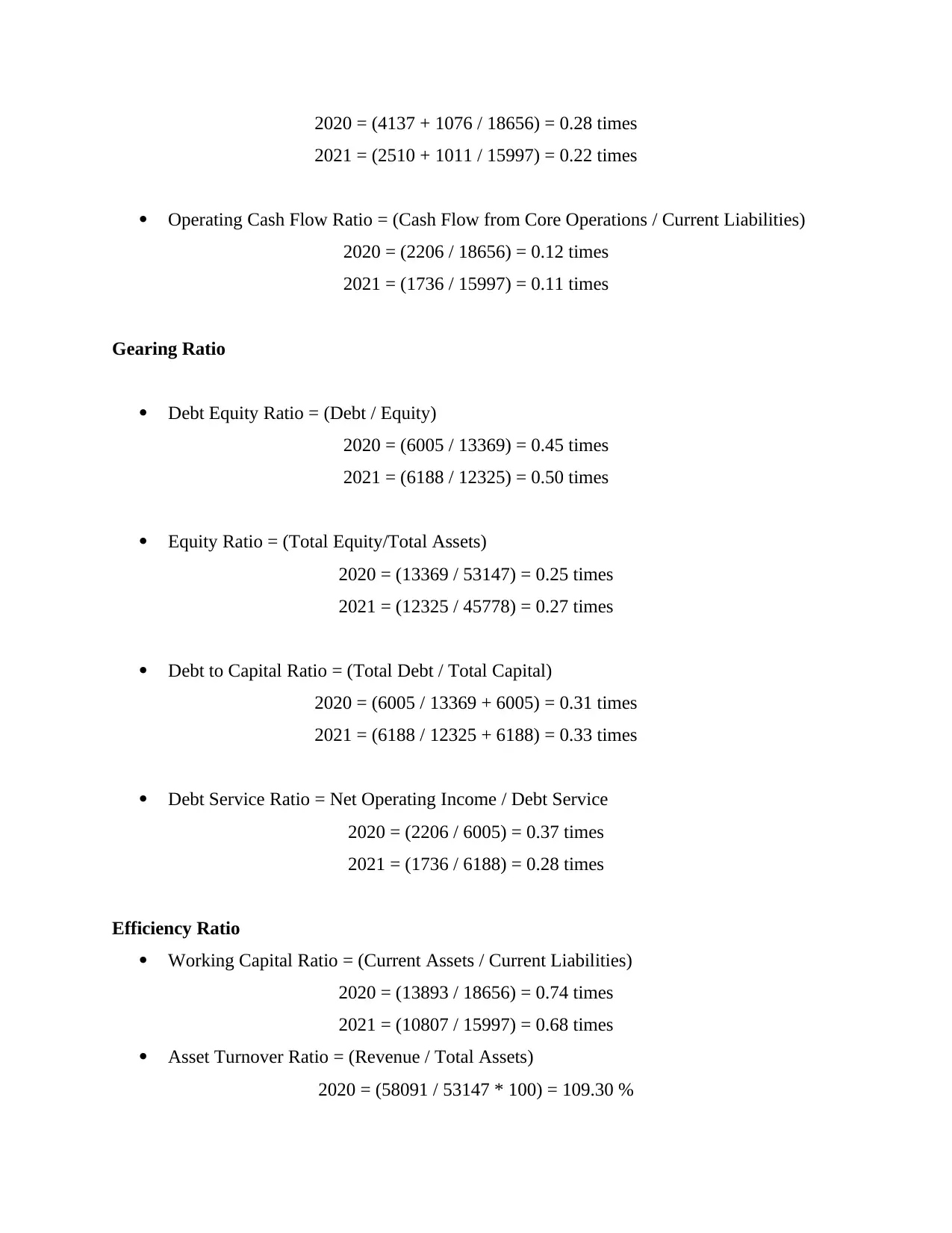
2020 = (4137 + 1076 / 18656) = 0.28 times
2021 = (2510 + 1011 / 15997) = 0.22 times
Operating Cash Flow Ratio = (Cash Flow from Core Operations / Current Liabilities)
2020 = (2206 / 18656) = 0.12 times
2021 = (1736 / 15997) = 0.11 times
Gearing Ratio
Debt Equity Ratio = (Debt / Equity)
2020 = (6005 / 13369) = 0.45 times
2021 = (6188 / 12325) = 0.50 times
Equity Ratio = (Total Equity/Total Assets)
2020 = (13369 / 53147) = 0.25 times
2021 = (12325 / 45778) = 0.27 times
Debt to Capital Ratio = (Total Debt / Total Capital)
2020 = (6005 / 13369 + 6005) = 0.31 times
2021 = (6188 / 12325 + 6188) = 0.33 times
Debt Service Ratio = Net Operating Income / Debt Service
2020 = (2206 / 6005) = 0.37 times
2021 = (1736 / 6188) = 0.28 times
Efficiency Ratio
Working Capital Ratio = (Current Assets / Current Liabilities)
2020 = (13893 / 18656) = 0.74 times
2021 = (10807 / 15997) = 0.68 times
Asset Turnover Ratio = (Revenue / Total Assets)
2020 = (58091 / 53147 * 100) = 109.30 %
2021 = (2510 + 1011 / 15997) = 0.22 times
Operating Cash Flow Ratio = (Cash Flow from Core Operations / Current Liabilities)
2020 = (2206 / 18656) = 0.12 times
2021 = (1736 / 15997) = 0.11 times
Gearing Ratio
Debt Equity Ratio = (Debt / Equity)
2020 = (6005 / 13369) = 0.45 times
2021 = (6188 / 12325) = 0.50 times
Equity Ratio = (Total Equity/Total Assets)
2020 = (13369 / 53147) = 0.25 times
2021 = (12325 / 45778) = 0.27 times
Debt to Capital Ratio = (Total Debt / Total Capital)
2020 = (6005 / 13369 + 6005) = 0.31 times
2021 = (6188 / 12325 + 6188) = 0.33 times
Debt Service Ratio = Net Operating Income / Debt Service
2020 = (2206 / 6005) = 0.37 times
2021 = (1736 / 6188) = 0.28 times
Efficiency Ratio
Working Capital Ratio = (Current Assets / Current Liabilities)
2020 = (13893 / 18656) = 0.74 times
2021 = (10807 / 15997) = 0.68 times
Asset Turnover Ratio = (Revenue / Total Assets)
2020 = (58091 / 53147 * 100) = 109.30 %

2021 = (57887 / 45778 * 100) = 126.45 %
Investment Ratio
Price Earnings Ratio = (Share Price / Earnings Per Share)
2020 = (289.43 / 7.60) = 38.08 times
2021 = (224.80 / 7.56) = 29.74 times
Return On Equity = (Net Income / Shareholders Equity)
2020 = (973 / 13369 * 100) = 7.28 %
2021 = (6147 / 12325 * 100) = 49.87 %
Investment Ratio
Price Earnings Ratio = (Share Price / Earnings Per Share)
2020 = (289.43 / 7.60) = 38.08 times
2021 = (224.80 / 7.56) = 29.74 times
Return On Equity = (Net Income / Shareholders Equity)
2020 = (973 / 13369 * 100) = 7.28 %
2021 = (6147 / 12325 * 100) = 49.87 %
⊘ This is a preview!⊘
Do you want full access?
Subscribe today to unlock all pages.

Trusted by 1+ million students worldwide
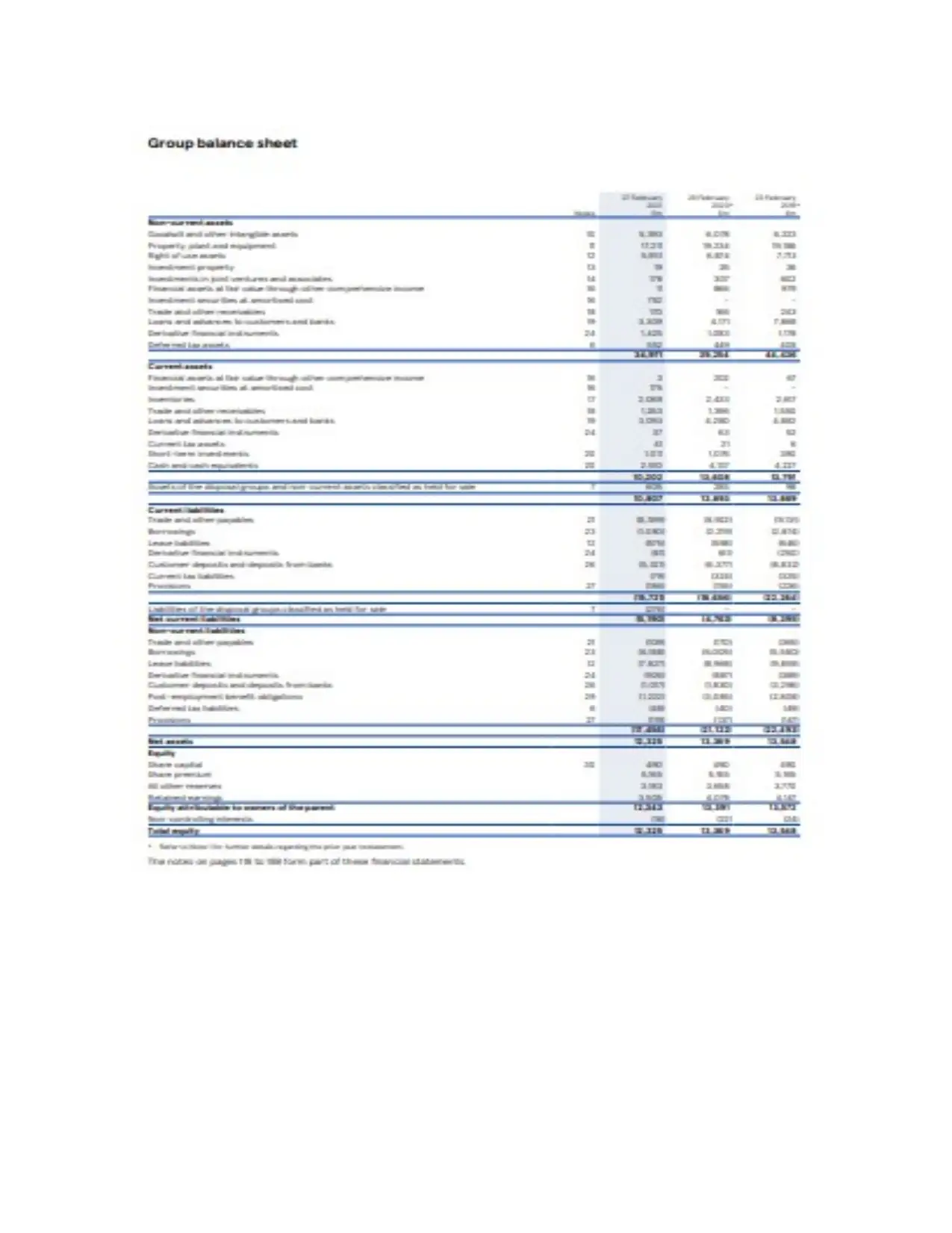
Paraphrase This Document
Need a fresh take? Get an instant paraphrase of this document with our AI Paraphraser
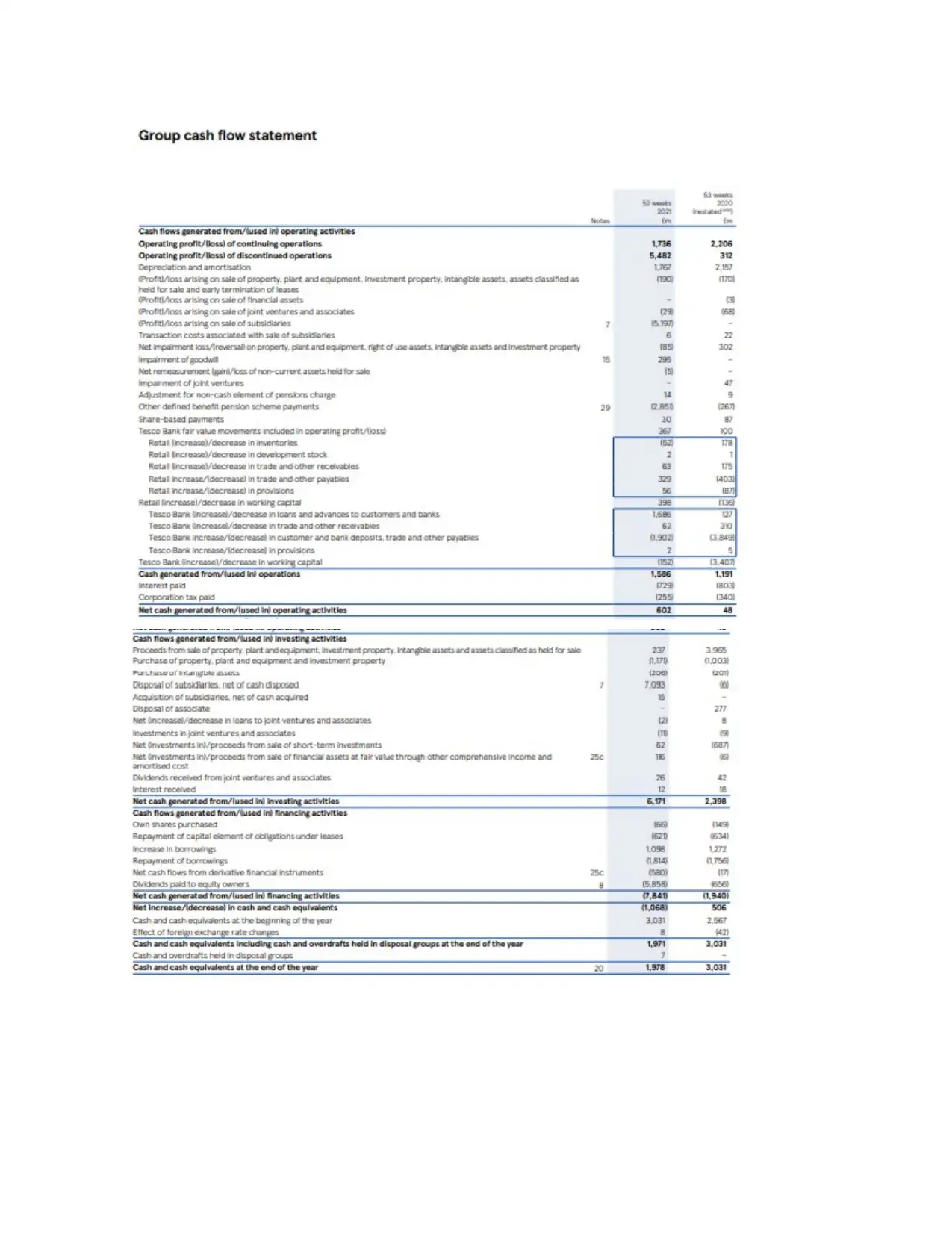
1 out of 17
Related Documents
Your All-in-One AI-Powered Toolkit for Academic Success.
+13062052269
info@desklib.com
Available 24*7 on WhatsApp / Email
![[object Object]](/_next/static/media/star-bottom.7253800d.svg)
Unlock your academic potential
© 2024 | Zucol Services PVT LTD | All rights reserved.



